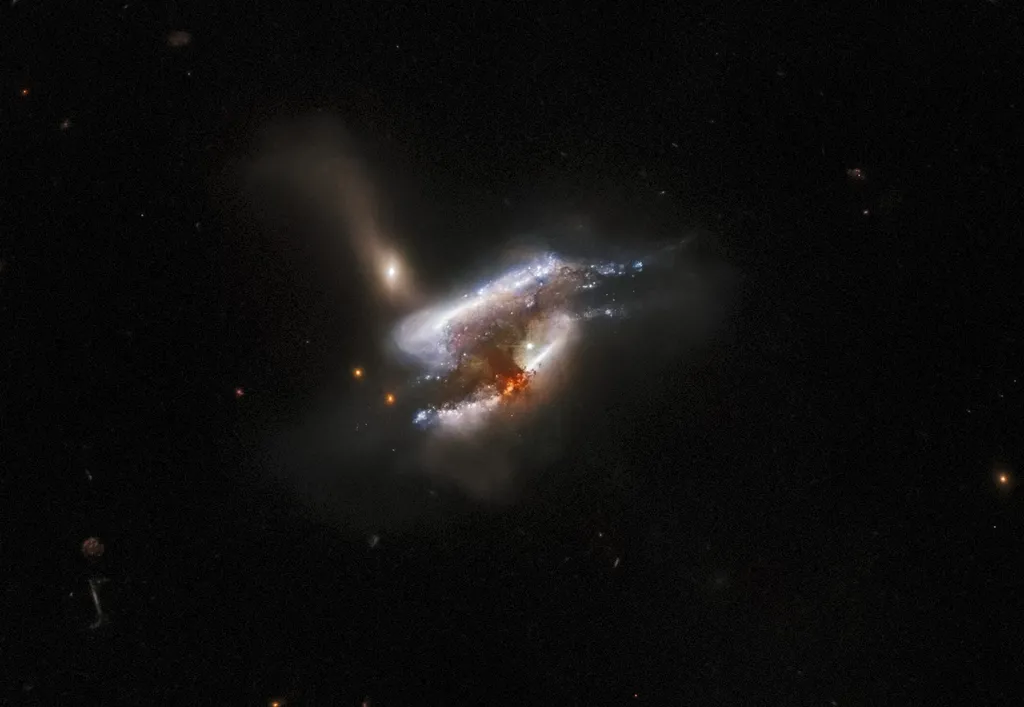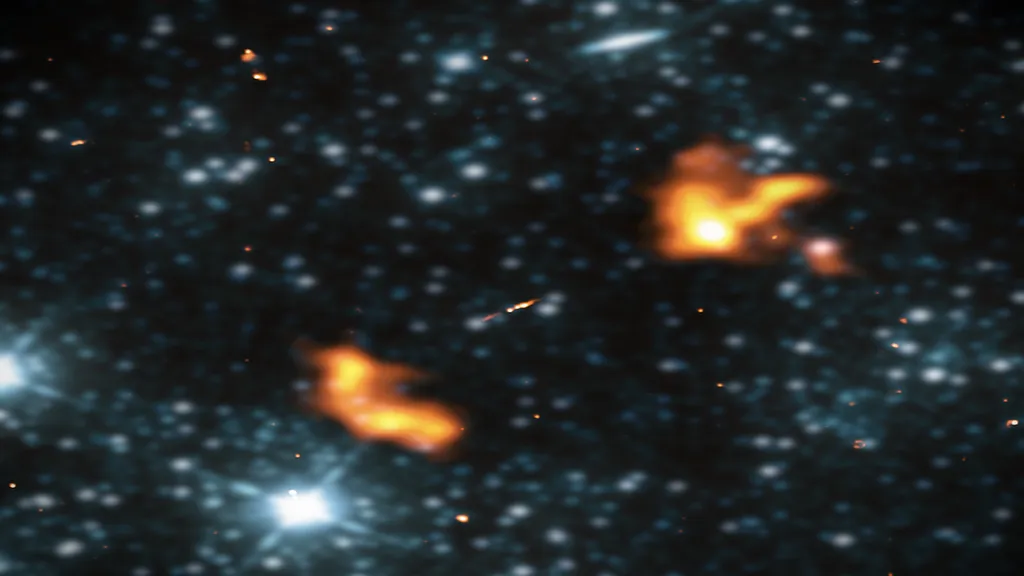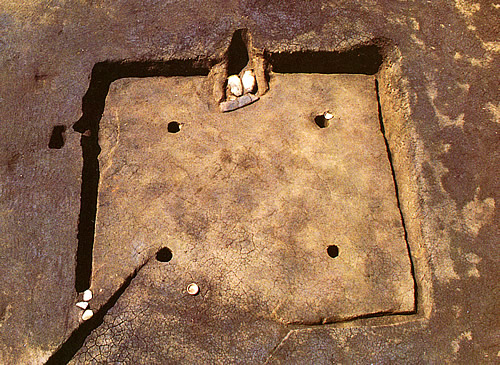The Zen of Technology & Scientific Discovery! (& Robots)
Yet all things are temporary. Unfortunately we will not be observing the galactic confluence. At least, not from Earth.
Gassho,
Nengei
Sat today. LAH.
The Zen of Technology & Scientific Discovery! (& Robots)
Collapse
X
-
Some photos that Zen folks might call your looking at other faces of your own self ...
A striking and unprecedented image of a solar eruption has been captured by NASA and the European Space Agency's Solar Orbiter spacecraft. [JUNDO: not to be confused with Webb ]
]
It's the largest solar prominence ever observed in a single image together with the full disc of the sun, ESA said in a statement released Friday.
The solar eruption took place on February 15 and extended millions of miles into space. The image was taken by the Full Sun Imager of the Extreme Ultraviolet Imager onboard the Solar Orbiter. ...
... these ejections are directed toward Earth, they can disrupt technology reliant on satellites. The ejections also cause the northern lights.
However, in this instance, the coronal mass ejection was traveling away from us.
https://us.cnn.com/2022/02/21/world/...scn/index.html
If it were headed this way ...
andThe flash of light from a flare takes about 8 minutes to reach Earth [at the speed of light]; solar material expelled from the sun in a coronal mass ejection (CME) may take hours to days to travel the distance.
https://astronomy.com/news/2021/09/u...%20many%20days.
Glowing clouds surround an exploded star in NASA mission's stunning first image
... A new pair of X-ray eyes on the universe is allowing us to see extreme objects like never before.
Just over two months after launching to space, NASA's newest explorer --- the Imaging X-Ray Polarimetry Explorer, or IXPE [JUNDO: not to be confused with Webb ] -- shared its very first images.
] -- shared its very first images.
And they are stunning. The images offer a glimpse of Cassiopeia A, the famous remnant of a supernova, or exploding star.
Glowing purple gas clouds can be seen around the remains of the star. These clouds were created when shock waves from the explosion heated surrounding gas to incredibly high temperatures, accelerating high energy particles called cosmic rays.
... The beautiful remnants of the Cassiopeia A supernova are located about 11,000 light-years away from Earth. It is now a giant bubble of hot, expanding gas, and it's the youngest known remnant from a supernova explosion, dating back 340 years ago, in our Milky Way galaxy. The light from this supernova first reached Earth in the 1670s.
https://us.cnn.com/2022/02/16/world/...scn/index.html
This image shows supernova remnant Cassiopeia A, combining the first X-ray data collected by NASA's Imaging X-ray Polarimetry Explorer in purple, with high-energy X-ray data from NASA's Chandra X-Ray Observatory in blue.

This IXPE image maps the intensity of X-rays coming from Cassiopeia A. The colors, including cool purple, blue, red and white, correspond with the increasing brightness of the X-rays.
Gassho, J
STLahLast edited by Jundo; 02-22-2022, 04:52 AM.Leave a comment:
-
More news on a galactic scale ... a glance into the future ...
ALL THINGS ARE CHANGE ... either flow with it, or it flows with you!
But some good news ...Three galaxies are tearing each other apart in stunning new Hubble telescope image
This twisty-turny collision is a preview of what awaits our galaxy.
Corkscrewing through the cosmos, three distant galaxies collide in a stunning new image captured by NASA's Hubble Space Telescope.
This cosmic crash is known as a triple galaxy merger, when three galaxies slowly draw each other nearer and tear each other apart with their competing gravitational forces. Mergers like these are common throughout the universe, and all large galaxies — including our own, the Milky Way — owe their size to violent mergers like this one.
As chaotic as they seem, mergers like these are more about creation than destruction. As gas from the three neighboring galaxies collides and condenses, a vast sea of material from which new stars will emerge is assembled at the center of the newly unified galaxy.
Existing stars, meanwhile, will survive the crash mostly unscathed; while the gravitational tug-of-war among the three galaxies will warp the orbital paths of many existing stars, so much space exists between those stars that relatively few of them are likely to collide ...
The galaxy cluster seen above is called IC 2431, located about 681 million light-years from Earth ...
Well, that's one less thing to worry about then!Meanwhile, our galaxy appears on track to combine with the nearby Andromeda galaxy about 4.5 billion years from now. The merger will totally alter the night sky over Earth but will likely leave the solar system unharmed, according to NASA.

Here is the Hubble Image (Hubble's still got it, Webb!)

Something vaguely Shiva-like in this dance of destruction which is also birth ...

Gassho, J
STLahLast edited by Jundo; 02-18-2022, 10:43 PM.Leave a comment:
-
Big while small, yet small is big ...
I guess that it is like a bag of chips, which looks big but is mostly space ...Largest galaxy ever discovered baffles scientists
Astronomers just found the largest galaxy ever discovered, and they have no idea how it got so big.
At 16.3 million light-years wide, the Alcyoneus galaxy has a diameter 160 times wider than the Milky Way and four times that of the previous title holder, IC 1101, which spans 3.9 million light-years, researchers reported in a new study.
... The galactic monster is an especially large example of a radio galaxy, or a galaxy with a supermassive black hole at the center which gobbles up enormous amounts of matter before spitting it out — sending gigantic two jets of plasma moving at close to the speed of light.
... But other than its gigantic plumes, Alcyoneus is a normal elliptical galaxy, with a total mass roughly 240 billion times the mass of the sun (half that of the Milky Way's) and a central supermassive black hole 400 million times the sun's mass (100 times less massive than the largest black hole). In fact, Alcyoneus' center is on the small side compared with those of most radio galaxies.
... For now, the astronomers are stumped, but they are investigating some potential explanations. One possibility is that the galaxy's surrounding environment has a lower density than is usual, enabling its jets to expand across unprecedented scales. Another possible explanation is that Alcyoneus exists inside a filament of the cosmic web, a vast and little-understood structure of gas and dark matter that links galaxies.
https://www.livescience.com/largest-galaxy-ever-spotted

Gassho, J
STLahLeave a comment:
-
I wish that all human endeavor could be focused on making our world better for all sentient beings. Stories like this give me hope.
Gassho,
然芸 Nengei
Sat today. LAH.Leave a comment:
-
Far removed from the Jomon period ... this is truly wonderful ...
3 paralyzed men can walk again after getting electrode implant
The device stimulates specific spinal nerves.
Three men with paralyzing spinal cord injuries can now stand, walk and cycle after electrodes were implanted into their spinal cords.
The electrodes deliver electrical pulses to specific regions of the spinal cord and thus activate muscles in the trunk and legs, according to a new study, published Monday (Feb. 7) in the journal Nature Medicine. The soft, flexible device lies directly on top of the spinal nerves, beneath the vertebrae, and can be controlled wirelessly with software, operated from a tablet, and a handheld clicker.
The software communicates with a pacemaker-like device in the abdomen, which then directs the activity of the nerve-bound electrodes on the spinal cord. So, with the tap of a touch screen, the user of the implant can prompt their device to generate a precise pattern of stimulation. These stimulation patterns translate to patterns of muscle activity, allowing the user to walk, cycle, or swim, for instance. Users can also manually switch between these stimulation patterns with their clicker. "All three patients were able to stand, walk, pedal, swim and control their torso movements in just one day, after their implants were activated ..."
After the initial implantation, the patients underwent extensive training to get used to using the device and regain muscle mass and motor control, co-senior author Dr. Jocelyne Bloch, an associate professor of neurosurgery at Lausanne University Hospital, told The Guardian. "It was not perfect at the beginning, but they could train very early to have a more fluid gait," she said. Eventually, the patients progressed from using the implants only in a controlled lab setting to using them out and about in their daily lives.
After four months of training, one patient, Michel Roccati, was able to walk about 0.6 mile (1 kilometer) outside the lab and without stopping, with only a frame for balance, AFP reported. He can now continuously stand for about two hours. Like the other participants in the trial, Roccati has a complete spinal cord injury, meaning the nerves below his site of injury cannot communicate with the brain at all. He was injured in a motorcycle accident in 2019 and lost both feeling and motor control in his legs.
...
The team is also investigating whether a similar stimulator could be implanted directly into the motor cortex, a key region of the brain for controlling voluntary movement, Courtine told NBC News. Such a device could allow people with paralysis to direct their movements without the aid of a tablet or clicker.
https://www.livescience.com/spinal-i...fter-paralysis


Gassho, J
STLahLeave a comment:
-
That is freakin' coolio. A true antiquity!
Gassho,
Nengei
Sat today. LAH.Leave a comment:
-
PS - A close up picture of the striation lines on the pot, made by rolling rope over the surface ...
The oven was like this ...



Similar chord designed pottery is found around the world, showing amazing similarities in peoples far removed from each other ...
Gassho, J
STLahLast edited by Jundo; 02-09-2022, 12:45 AM.Leave a comment:
-
Well, a little mystery partially resolved in the Cohen house, but new mysteries added.
I found this old pot in a local junk shop about 3 years ago, and suspected that it is a kind of old rice cooking pot from maybe the Kofun (Burial Tumulus) Age in Japan, about 1500 to 1800 years ago. Because of Covid, I never got to show it to an expert, but finally did yesterday, asking our local city archeologist his opinion (yes, cities in Japan, like many in Europe, have town archeologists, because they are always digging up old things).
Turns out that I was partly wrong. While it appears to be an old rice cooking pot, it seems to be from the much earlier Late/Final Jomon period, the end of the Japanese stone age, about 1500 B.C. to 300 B.C., so maybe 2,500 or 3,000 years old? It is partially restored by someone, but we don't know how it ended up in the junk shop.
Now, here is the mystery. First, it does not appear to be from this region, but may be from Hokkaido in far northern Japan. However, rice had just come to Japan at the time, and is not thought to have made it this far north. So, it must be from Kyushu in southern Japan, in the very early days of rice cultivation in Japan! However, he is not sure, and it will need further research. He is only sure that it is late Jomon period.Late Jōmon (ca. 1500–1000 B.C.)
As the climate began to cool, the population migrated out of the mountains and settled closer to the coast, especially along Honshū’s eastern shores. Greater reliance on seafood inspired innovations in fishing technology, such as the development of the toggle harpoon and deep-sea fishing techniques. This process brought communities into closer contact, as indicated by greater similarity among artifacts. Circular ceremonial sites comprised of assembled stones, in some cases numbering in the thousands, and larger numbers of figurines show a continued increase in the importance and enactment of rituals.
Final Jōmon (ca. 1000–300 B.C.)
As the climate cooled and food became less abundant, the population declined dramatically. Because people were assembled in smaller groups, regional differences became more pronounced. As part of the transition to the Yayoi culture, it is believed that domesticated rice, grown in dry beds or swamps, was introduced into Japan at this time.
https://www.metmuseum.org/toah/hd/jomo/hd_jomo.htm
Here are two pictures. It was a functional device, a family's kitchen vessel not made for beauty. However, you can see the lines carved into the surface, using a pressed rope pattern to make the design. The blackness either comes from the firing of the pottery or long use in cooking.
The hole shows that it was probably a steamer for rice, used in some kind of oven like this ...

So, new mysteries to investigate!
The pot is not of financial worth in any way, but does have historical and personal value!
Gassho, J
STLahLast edited by Jundo; 02-09-2022, 05:38 AM.Leave a comment:
-
I want a Zafu that is harder than steel and bulletproof (in case the Zendo is attacked!) ...
...
Gassho, JMIT researchers have developed a new material that's as strong as steel but as light as plastic.
It can be easily manufactured in large quantities, and the use cases range from lightweight coatings for cars and phones to building blocks for massive structures such as bridges, according to Michael Strano, the Carbon P. Dubbs Professor of Chemical Engineering at MIT and the senior author of a new study.
“We don’t usually think of plastics as being something that you could use to support a building, but with this material, you can enable new things,” he said in a statement from MIT. “It has very unusual properties and we’re very excited about that.”
The material is several times stronger than bulletproof glass, and the amount of force needed to break it is twice that of steel, despite the fact that the material has only about one-sixth the density of steel, according to MIT.
The researchers were able to do this by developing a new process to form polymers. Plastics are an example of polymers, along with rubber and glass. ...
https://www.usatoday.com/story/tech/...newstopstories
STLahLeave a comment:
-
Life truly does find a way ...
Why a toxic volcanic lake on Earth reminds scientists of Mars
In the heart of the Costa Rican rainforest is a bright blue lake full of toxic metals. Clouds of stinging steam drift around the active volcanic crater hosting one of Earth's most acidic lakes. Located near the summit of the Poás volcano, Laguna Caliente is subject to frequent eruptions, releasing explosions of ash, rock and steam -- and sometimes roiling magma.
Yet microbes have found a way to live in this environment, one of the most hostile on our planet, according to multiple studies of the lake and new research published last week in Frontiers in Astronomy and Space Sciences.
Although the diversity of the life in this lake isn't high, it has managed to adapt and persist in a multitude of ways.
https://www.frontiersin.org/articles...22.817900/fullLaguna Caliente presents an extremely dynamic terrestrial environment with near-ambient to boiling temperatures, pH fluctuations from −0.87 to 1.5, a wide range of chemistries and redox potential, and frequent phreatic-to-phreatomagmatic eruptions. Samples of lake fluid, sulfur clumps, and lake bottom sediment underwent 16S rRNA gene sequencing and metagenomic “shotgun” sequencing, which revealed this lake hosts an extremely low biodiversity of microorganisms dominated by Acidiphilium spp. Shotgun metagenomics of the samples suggests this community has numerous genetic adaptations that confer survival, including functional pathways to reduce the effects of toxic metals and numerous metabolic pathways utilizing a variety of simple and complex sugar molecules. The identification of these various metabolic pathways suggests adaptations related to carbon limited environments, fulfillment of high energy requirements, and survival in a hostile volcanic setting. The perseverance of life in Laguna Caliente indicates life on Mars could have thrived in analogous environments, stressing the need for the search for life in relict Martian acid-sulfate hydrothermal systems.
Gassho, J
STLahLeave a comment:
-
Some cool space stuff from today, behold the 'mysterious strands'!
 More than 35 years ago, a Northwestern astrophysicist discovered mysterious, giant filaments in the center of the Milky Way. Now, he uncovered 10 times more than previously known.
More than 35 years ago, a Northwestern astrophysicist discovered mysterious, giant filaments in the center of the Milky Way. Now, he uncovered 10 times more than previously known.
Some of these are 150 light years long... 1 light year is about 10 trillion kilometres...
A radio view of what these look like: https://www.flickr.com/photos/astro_jcm/51847931721
Gassho,
./sat
NeilLeave a comment:
-
Wonderful to see knoll talked about. This thread is awesome, thankyou jundo.
LaH
SatToday
GasshoLeave a comment:





Leave a comment: